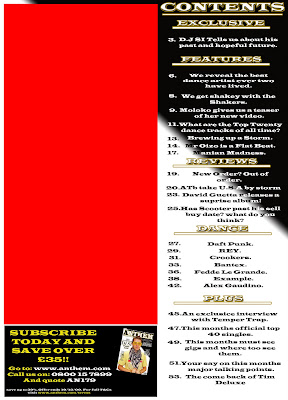
I began by creating a double page spread and inserting the article in a bold text. I based by feature article on the article I analysed from the 'Look' magazine which is about a music artist. I used the basic convention of using
columns to lay out my
article because they are in all of the magazines i analysed and it is easier to read.
Here is a copy of my interview that can be seen above.
Peter Simons, otherwise known as DJ SI, is not your average Disk Jockey. Aged just 19 he is one of Britain’s best up and coming DJ’s and with hits such as ‘Around the corner’ and ‘Proud Point’ he’s slowly working his way into the open arms of dance music enthusiasts. At 16 he was an addict to house music but he says with as he is maturing, his style of music is changing. When he was just 17 he had a very lucky break with record producer David Samson who released his two singles which, unfortunately, stayed out of the limelight. With his early background of house music he should find it very easy to adapt to the ever so different yet more popular style of dance music. Now aged 19 he is starting to make a name for himself as a regular house DJ for his uncles club, he is even talking of an album release in the summer of next year. In his first interview, he tells ANTHEM exclusively about his life and how he has got to where he is now...
It’s been a fast few years for your Peter.
How are you coping with being placed into the public view so rapidly?
Well I have just continued to do the things I enjoy, like playing football and socialising with friends. I’m finding it hard though trying to adapt to the busy lifestyle of a music artist it’s like being back at school. David [Samson, Peter’s producer] keeps giving me these deadlines that my songs have to be done by in order to fill the album for next summer, its hard work but I enjoy it.
You met David Samson last year, how did you meet? Was it organised?
Organised? Far from it. I was messing around in the DJ box in my uncles club before it opened and he [David] was in a meeting with my uncle trying to organise a dance night for the following month. As I started playing my remix of ‘Show Me Love’ by Steve Angelo he and my uncle just strolled into the room and sat down, without me knowing. My uncle was showing Dave the sound system because he had just invested in a new subwoofer for extra base. Dave then stopped my uncle and said that he wanted me to play a few songs on the music night they were organising so I could show them what I could do, and it escalated from there.
Who has been your biggest influence?
That’s a hard one. Overall I would have to say that my uncle influenced me the most and helped me significantly to get where I am today because of his business. After I played some music at his club he let me work more during the week, when I wasn’t studying that is. The other person who influenced me massively by his music is Joel Zimmerman who is better known by the name Deadmau5 (dead mouse). He created some brilliant music like ‘Arguru’ around the time I met David and was working in my uncles club. His type of music really influenced what I did to songs to make them more dance orientated. I have even had the pleasure of being his support act.
I understand that, when you were 17, you were knocked down by a car and spent 12 months in hospital. How did that shape who you have became?
The accident gave me time to think, lots of time to think, and it made me more focussed on what I wanted to do. It was a major turning point in my life. Whilst all my friends were out doing drugs and getting nowhere in life, I was sitting in hospital, thinking about what I could do. My parents also bought me a laptop to help me recuperate. I was very inventive on it, I even used it to do the ‘Show me love’ remix which in turn helped me meet David, so it was a hugely significant period in my life.
What made you make the change from house music to dance music?
I feel that house music is heavier than dance music. If you listen to house you are usually at a party or a club but dance has a wider variety. By that I mean it is played in clubs and parties but it is also listened to it whilst driving or just chilling. I listened to Dance music so much when I was I was recovering in hospital and I decided from that point that dance music was they way forward, don’t get me wrong I still love house music but dance is more liked and preferred by more people.
Is it right that just last week you finished filming your vary first music video? How did it go and when can we expect to see it?
Well the video is for the song ‘Many Colours’ which is on the new album but the single is out before the album is released in July so you can expect to see ‘Many Colours’ any time after March next year. The video shoot itself went extremely well. We actually filmed it in Hamsterley forest, in Teesdale to give it that crisp autumn feel about it. After all the song is called many colours, and autumn is full of many colours, which captures the feel of the song.
So far in your short career, what has been the most memorable moment?
Well, like I mentioned earlier I was the support act for deadmau5 last summer. That is by far the most memorable moment of my career so far; I was on just before him so it was a full crowd, 13,678 to be precise, only 322 off the maximum capacity of 14,000 people in the 02-arena In Birmingham. It was a view I will never forget; thirteen and a half thousand people jumping up and down and screaming at your music, it made me realize just how much I like to do my job. As it was last year I was 18 at the time and after the show ended I actually went out clubbing. I will never forget what Joel said to me that night, “you are a very talented DJ, keep going, you will do well”. This was a massive motivation; it made me feel like I was on top of the world.
You’ve have only been doing your job professionally for the last few years; what have been the main high and low points?
Well, my high point was doing that gig with Joel (deadmau5). The only thing that could ever top that is if maybe I was where he is now, a world famous DJ with thousands of people turning up to watch me. So far I haven’t had a low point, just slow periods where ideas aren’t running through my head as clearly as they usually do, but hopefully I won’t have a low point. [Laughs]
Which famous DJ would you compare your music to the most?
Well, there’s David Guetta, the unforgettable Tiesto and obviously Deadmau5. But the DJ I would most compare my music to would have to be Judge Jules. Judge Jules is a magnificent DJ, renowned for his outstanding remixes and rhythms. He is an English DJ and has worked on the radio and in clubs all over the world and like me he remixes dance music, he’s a legend!
You have already mentioned that your album will be out next July. What can we expect to get on the album, have you got any surprises for us?
There are a few good surprises on there but I’m afraid I can’t reveal what they are quite yet. All I can say is some well renowned people have worked with me on this album. I’m relieved to say that it is almost near completion; I just need to finish two more tracks and the bonus track. The problem is though that I’m a perfectionist. After I finish the album I have set aside several days to go over the songs with a fine toothcomb and make any necessary tweaks to make it better. As for the overall content of the album, personally, I love it. It is basically a compilation of all my favourite work and the new songs I have done with the likes of Calvin [Harris]. Oops, I let that one slip. [Laughs]
What is your favourite song of all time?
That’s a tough one. My favourite song would have to be (pauses) ‘Day and Night by Kid Cudi and the Crookers. For some reason I just really love that song and can never get sick of it. A close contender is a song by my idol ‘Deadmau5’ it has always been a brilliant tune. The one I am on about is ‘I Remember’ I just think it is a brilliant Ibiza chill out Song.
What is the funniest thing that ever happened to you at an event?
The funniest thing would have to have been when I was working in my uncles club last month. It was all going well, I was loving it, the crowd were loving it, and then there was a power cut.
Really, what did you do?
Luckily the back up generator kicked in within 30 seconds of the power cutting off, but that was a long 30 seconds. Silence in a music dance club is never a good thing. When I got going again the night went very well.
If you could do a gig anywhere, where would it be and why?
Well, I went to Ibiza last year for a ‘lad’s holiday’ and I loved every aspect of it, especially the music. One night went into ‘Amnesia’, it was truly amazing, just the thrill of the music thumping through your body. It’s indescribable. To be standing in the biggest club in the world dancing to music I love. If I was able to be of that standard in the next few years I would love it. I can’t even imagine how good it would feel to perform in Ibiza, the dance music centre of the world, in front of thousands of people a night, it would be unbelievable.
What do you think of MC’s?
Ergh, I don’t see the point in them! Why ruin a song by shouting over the top of it? I mean we all do it but only for a laugh, I don’t know how people can listen to it and enjoy it at the same time, it’s bizarre?
Do you remember what the first song is that you purchased?
Yes, I do actually. I was only about nine and I and my friend paid half each for Bobby Browns song ‘Two Can Play That Game’. We completely overplayed it but at the time we thought it was the best song in the world
Where do you see yourself in five years?
I can’t say where I will be or what I will be doing, but hopefully I will have had some number ones! [Laughs]. I really hope that I become a world renowned DJ like Tiesto or David Guetta but you never know what will happen do you?
If you did become a world famous DJ, would you still live in the North East?
I love the North East but if I was world famous I would probably live my dream and live in Ibiza and DJ. The weather is just too cold and wet in England but if I was in Ibiza I could just sit outside anytime I wanted. You have to plan it here.
Would you prefer to be a radio DJ or a club DJ and why?
I have never really thought about it but if I had a choice I would probably say club D.J because of the feeling of thousands of people screaming and shouting; that sort of an atmosphere is something that cannot be created or felt in a radio studio.
Is there any advice that you would give to any up coming DJ’s?
Yes, I would just say to stick with what there doing and keep looking for that break. As soon as you get a break you will be on your way to fame.
If you were given the chance to start over and choose any career, what would it be? That’s an interesting one. I would probably say that I would be a professional footballer, purely for their wages. I used to play for the district when I was about 13 but I had to stop because of a double hernia.
So does that mean that you can’t play any football at all?
Well I can play football but not at any serious level, I can have a kick around for a while but if I push myself too hard it can seriously hurt.
You are a great DJ, but can you sing a song?
Well, I can just about talk my way through an easy song ‘Chasing Cars’ or something similar. But if you ask me to sing a song, you have no chance; it would sound like you were strangling a cat.
And finally, Knight Rider or A-team?
This is the question I have been dreading the most. [Laughs]. But I would have to say A-team.

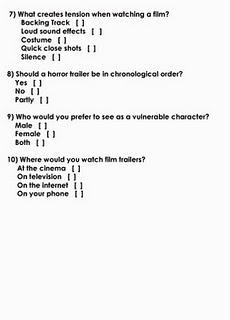
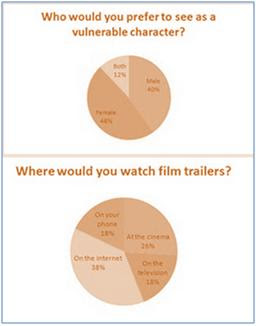
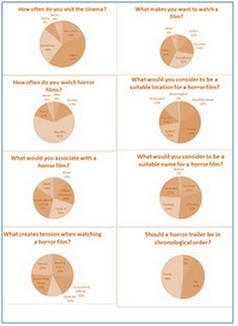





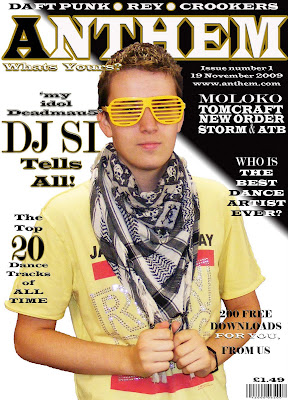
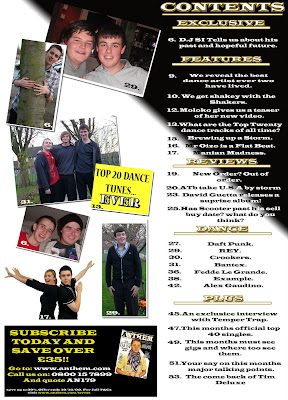
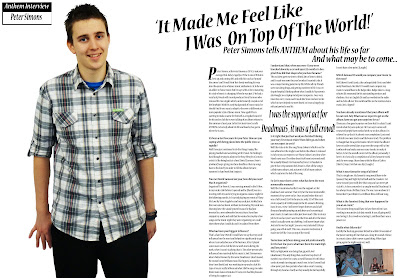





 By carrying out this research I was able to use many of the conventions of existing, popular magazines in my music magazine. For example, the vibe magazine uses only four colours: red, gray, white and black. It also has the model in front of the title, has a menu bar across the top with artists who are featured in the magazine, catchy hooks, large attractive writing, and a clear presentation. I decided to use these conventions in my magazine, by using only three colours; black, white and yellow, the magazine is similar to already existing products. This basic colour scheme will help the buyer recognise it for any future purchases.
By carrying out this research I was able to use many of the conventions of existing, popular magazines in my music magazine. For example, the vibe magazine uses only four colours: red, gray, white and black. It also has the model in front of the title, has a menu bar across the top with artists who are featured in the magazine, catchy hooks, large attractive writing, and a clear presentation. I decided to use these conventions in my magazine, by using only three colours; black, white and yellow, the magazine is similar to already existing products. This basic colour scheme will help the buyer recognise it for any future purchases.

 The Mojo contents page helped to give a better understanding of the layout I would use for my contents. I decided to take the best out of both the NME contents and the Mojo contents. I used the basic layout of the Mojo contents but replaced the three pictures with an advertisement. Instead of the articles stopping where the pictures stopped I decided to continue them all the way to the bottom of the page. Also, the pictures on my contents page contain numbers which directly link them to the article or feature on the side of the page.
The Mojo contents page helped to give a better understanding of the layout I would use for my contents. I decided to take the best out of both the NME contents and the Mojo contents. I used the basic layout of the Mojo contents but replaced the three pictures with an advertisement. Instead of the articles stopping where the pictures stopped I decided to continue them all the way to the bottom of the page. Also, the pictures on my contents page contain numbers which directly link them to the article or feature on the side of the page.
 I decided to use this double page article as the style model for my article. I decided to do this because the lay out is simple and intriguing, the colour scheme is very simple and there is a full page dedicated to the model.
I decided to use this double page article as the style model for my article. I decided to do this because the lay out is simple and intriguing, the colour scheme is very simple and there is a full page dedicated to the model.







